Junya Ishigami envisions "beautiful mountain range" for Kinmen ferry terminal
News: Japanese architect Junya Ishigami has been named as the winner of a competition to design a ferry terminal for the Taiwanese island of Kinmen.
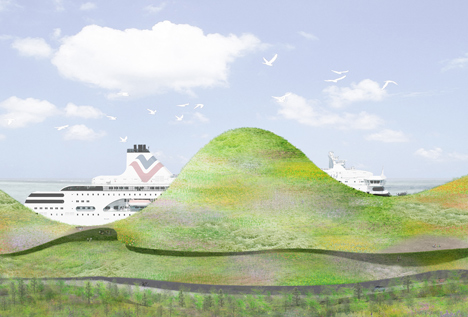
Under the title Landscape as a Monument, Ishigami envisions the Port of Kinmen passenger terminal as a 500-metre-long park resembling a "beautiful mountain range," in accordance with the natural landscape of the island, located off the coast of China.
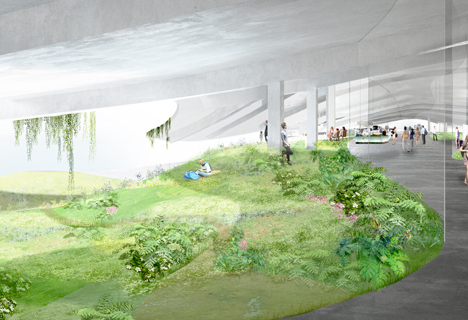
"We would like to design this ferry terminal as a landmark that symbolises Kinmen Island," said Junya Ishigami + Associates in a statement.
"We believe that a landmark of a new era, rather than simply being an object of prominence, should be like an oasis where everyone, locals and visitors, feel at peace with themselves."
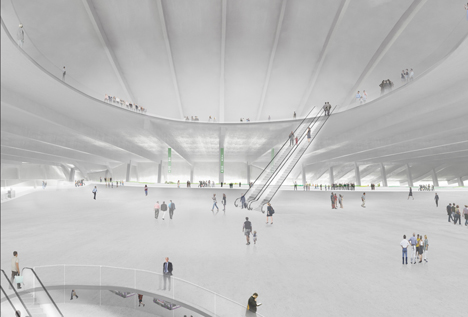
The structure will alternate between three and four storeys in height, creating a series of tiered rooftops that form the surface of the park.
"This roof of three levels creates a three-dimensional landscape, allowing people who visit to stroll around in various ways," said the studio.
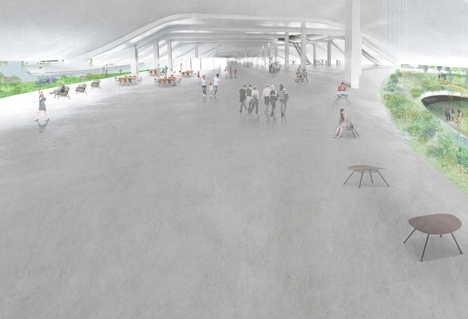
A diverse variety of plants will be installed across these roofs. High-level windows will bring a sea breeze through the interior, while deep eaves will help to offer shade.

Junya Ishigami + Associates developed the project in collaboration with Taiwanese studio Bio Architecture Formosana Architecture.

Here's the full statement from the design team:
A Landscape as a Monument, a Ferry Terminal as a Park
We would like to design this ferry terminal as a landmark that symbolises Kinmen Island. We began by considering what indeed would be a landmark appropriate for this new era, in the context of us who live in the 21st century. We believe that a landmark of a new era, rather than simply being an object of prominence, should be like an oasis where everyone, locals and visitors, feel at peace with themselves. It requires an appeal that naturally leads us towards its this place, as if discovering an oasis in the desert. We would like to propose this ferry terminal, a vast artefact spanning over a length of 500 metres, as a beautiful "mountain range". We aim to design a rich ecological system in the artificial site.

As one approaches the island from a distance by ferry, one can glimpse a series of small mountains appearing on horizon. As one approaches closer to the land, the city reveals itself amidst the crevice of the mountains, and further overlaps with the mountain range behind it situated in the centre of the island, allowing one to experience the vast landscape. Those who visit can experience a landscape that deeply engraves itself in memory, before arriving at the island. As this mountain will be continuous to the surrounding park, people who visit the location can explore the succession of mountains at their leisure, gazing upon the ocean and the city, and see off their acquaintances disembarking by boat.

The ferry terminal we propose is a "landscape as a monument" that consists of a rich ecological system. Also, the ferry port we propose is a "gate as a park" where everyone, local civilians locals and visitors, can meet and communicate.
To those who visit, we will provide the impact of a monument, a multifarious and rich experience of a landscape, and the park with the image of peace where people relief can relieve their minds.
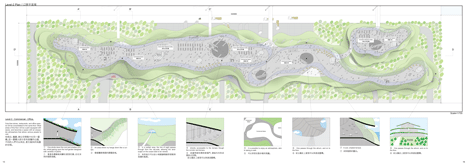
A Three-level Roof and Environment
The ferry terminal we propose is comprised of a three-level (partly four-level) roof. Each roof in each layer is equipped with deep eaves, creating many pleasant spaces of shade within the location.
Furthermore, by opening the windows depending on the season, a fresh sea breeze drifts through the inside of the building. In addition, various plants are planted in accordance with a meticulous vegetation plan on the top surface of each roof, transforming themselves into a beautiful park. This roof of three levels creates a three-dimensional landscape, allowing people who visit to stroll around in various ways.
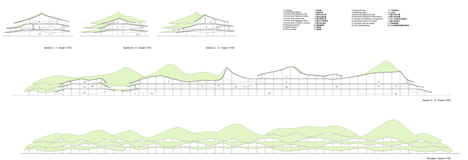
The cross-section of the lateral side possess characteristics of traditional Asian architecture, equipped with its deep eaves, its shape much akin with Kinmen's traditional colonial settlements that have an elegant curvature. Through its profile, repeating and overlapping whilst gradually altering itself, the entire building transforms into a landscape bestowed with various countenances.
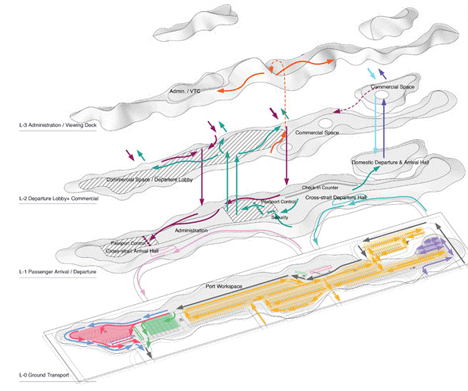
Its condition is like a mountain. The successive sections of various different shapes of concrete volume continue to form the interior space; it reminds me of the space of the Zhaishan Tunnel.
This means a pleasant environment created through a cross-section format with traditional deep eaves, the a succession of Kinmen's architectural image, and a unique characteristic as a landmark and park environment established by the mountain-like landscape, will be simultaneously planned for this location.